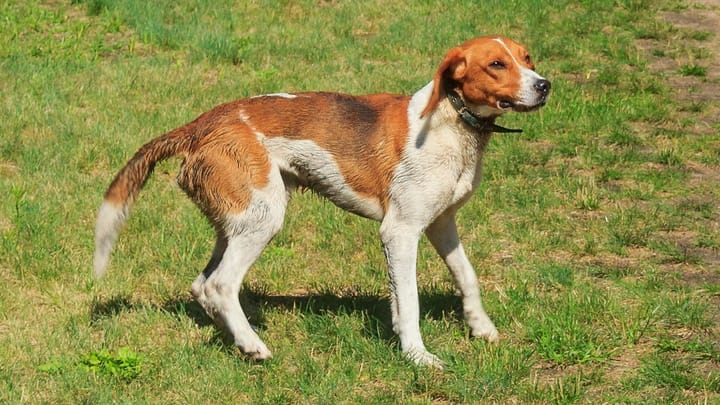German Hound
Other name: Deutsche Bracke

Known mostly by her German name in the UK, the Deutsche Bracke or German Hound is a three-coloured, medium-sized hunting dog. While she still finds work as a hunting dog (her pointer heritage seems to suggest dalliances with beagles, greyhounds, and bloodhounds along the way) she also makes a sturdy family pet. It is to be noted that neither the UK nor US Kennel Clubs recognise this breed.
|
Life expectancy |
The German Hound has a life expectancy of between 12 and 14 years |
|
Temperament |
|
|
Size |
Small
|
|
Adult size |
Female
Between 16 and 21 in
Male
Between 16 and 21 in
|
|
Adult weight |
Female
Between 42 and 44 lb
Male
Between 42 and 44 lb
|
|
Coat colour
Red-yellow, black, and white. |
Black White Red Brown |
|
Type of coat
The German Hound's hair is short and dense. |
Short Hard |
|
Eye colour
The German Hound's eyes are brown. |
Brown
|
She is not currently recognised by the UK Kennel Club and her number is low across these cursed isles.
More details about the German Hound
German Hound: Origins and history
First described by German artists and scholars in the 18th century, it is believed the ‘German Hound’ existed for some time before that. She was apparently brought into existence by ongoing experimentation to create a ‘utility’ hunting dog capable of multiple tasks in multiple conditions in the field. The beagle, English pointer, and bits of different foxhounds may have been thrown in the pot, along with the greyhound and the bloodhound. Although she hails from the Sauerland and Westphalia regions of Germany, she has become popular across that country as both a hunting and a family dog, but has struggled to make a name for herself outside of her homeland and especially beyond mainland Europe.
Physical characteristics of the German Hound
Light and nimble yet noble and strong, the Bracke looks something like a svelte beagle. She has a long, arched body, deep chest, and long slender snout. Her long, silky, rounded ears pair with soulful eyes to give the Bracke a deluxe look, even if she is well-suited to outdoors adventures and hard work. Her three-coloured fur is formed from a reddish-yellow, over which appears to be thrown a black ‘blanket’ or ‘saddle.’ The look is completed by white ‘bracken’ marks on her chest, legs, brow, and the tip of her tail. The splash of flesh-colour on her snout is her trademark.
FCI classification of the German Hound
-
Group 6 - Scent hounds and related breeds
-
Section 1 : Scent hounds
German Hound: Characteristics
German Hound: Behaviour
Training a German Hound
The Bracke’s seed of independence will be nourished by neglect ; she requires firm, confident training to develop into a sensible and reliable adult and potential hunting companion. But she is eager to learn, when engaged from a young age, and responds well to treats and encouragement – just beware, unannounced smells and foolhardy cats and squirrels can disrupt the classroom atmosphere in a blink.
German Hound: Lifestyle
Breed compatibility German Hound
German Hound: Purchase price
This breed is very popular in Germany but not in the other countries, therefore it will be difficult to find a German Hound dog. We do not have enough information to establish an average price for this dog.
The Deutsche Bracke can cost around £25-30 per month to feed and maintain.
German Hound: Shedding
Average
She does not lose undue amounts of hair.
German Hound: Grooming
There are no particular grooming needs for this breed, beyond that which you would expect for the species in general. Regular brushing and nail-clipping are a must, and special attention should be paid to her ears on returning from an adventure across wet or muddy ground. Quite brilliantly, her coat can generally be expected to repel dirt and water.
German Hound: Health
12 to 14 years.
The Bracke is both strong and robust despite her elegant appearance. Built for adventure.
There are no special considerations for this breed in hot weather, aside from the general dog rules of providing continuous sources of shade and fresh water.
The Bracke is quite capable of tolerating cold weather when out and about, and may indeed seem invulnerable to anything nature throws at her ; all the same, she should not be made to live outdoors and should instead spend the nights in your home.
She has a great need to expend her energy, so if you fail to give her the exercise she requires then she may start to pile on the pounds. Other than that, the Bracke does not present any particular concern – although over-fast eating can result in temporary (but painful) bloating.
- Eye illness : Cataracts, glaucoma, and progressive retinal atrophy
- Hip dysplasia

